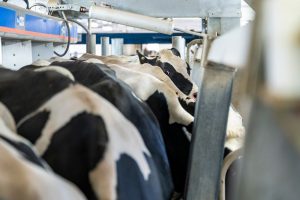
- H5N1 avian flu virus survived in raw dairy milk kept under refrigerated conditions for at least five weeks.
- When mice consumed infected raw milk, they showed signs of illness, suggesting that drinking raw milk may pose a risk of transmission to people.
- Heating milk in ways similar to pasteurization significantly reduced levels of the virus.
Certain influenza viruses are found in wild and domestic birds, earning the disease they cause the name “bird flu.” Over the last two decades, about 900 people have been infected with an avian influenza virus called H5N1. Most of them have had close contact with infected birds.
Past H5N1 strains have proven deadly for people, killing about half of those they’ve infected. However, to date, these H5N1 viruses haven’t spread effectively from person to person, limiting their potential to cause a pandemic.
In the past few years, a highly pathogenic avian H5N1, called HPAI H5N1, has spread from birds to infect more than 50 other animal species, including many kinds of mammals. In late March of this year, the first outbreak of HPAI H5N1 virus in dairy cows in the U.S. was reported. Three infections of people working with dairy cows have been picked up by virus surveillance methods. So far, symptoms have been mild.
HPAI H5N1 hasn’t yet gained the ability to spread directly between people. But researchers are concerned that infections could happen through the consumption of raw milk. Dairy milk purchased in the grocery store has been pasteurized—heated to a level high enough and long enough to kill most viruses or bacteria in the milk. However, 30 states in the U.S. allow the sale of raw dairy milk in some form.
In a new NIH-funded study, researchers from the University of Wisconsin-Madison, Wisconsin Veterinary Diagnostic Laboratory, and Texas A&M Veterinary Medical Diagnostic Laboratory used mice to test whether HPAI H5N1 found in raw milk can cause infections. Results were published on May 24, 2024, in the New England Journal of Medicine.

The researchers collected milk samples from cows in New Mexico that had been infected with HPAI H5N1. The samples contained a total of 8 different HPAI H5N1 viruses.
The team first heated infected milk at 63°C (145°F) for 5, 10, 20 or 30 minutes. All these experiments reduced the virus to levels that couldn’t be detected by a standard test. When using higher heat—72°C (161°F)—for briefer periods of 5, 10, 15, 20 or 30 seconds, levels of the virus were reduced but not eliminated.
These temperatures mimicked those used in milk pasteurization. The experiments suggest that heat may be able to neutralize HPAI H5N1 in dairy milk. However, additional work is needed to directly test whether industrial pasteurization methods kill the virus.
The researchers also stored raw milk infected with H5N1 in refrigerated conditions (4°C, or 39°F) for 5 weeks and found only a small decline in virus levels. This shows that the virus can likely remain infectious in raw milk when maintained at refrigerated temperatures.
Finally, the scientists fed milk from a cow infected with an HPAI H5N1 strain to five mice. All animals showed signs of illness by 1 day after exposure to the milk. When the team examined the animals’ organs 4 days after infection, they found HPAI H5N1 throughout their bodies, including the nasal passages and lungs. The results suggest that consumption of raw milk may pose a risk for H5N1 infection.
“We must emphasize that the conditions used in our laboratory study are not identical to the large-scale industrial treatment of raw milk,” notes lead researcher Dr. Yoshihiro Kawaoka of the University of Wisconsin-Madison. “It’s important to remember that our heat-treatment findings may not perfectly translate to real-world conditions.” However, to date, there hasn’t been evidence that commercially pasteurized milk poses an infection risk.
You can now read the most important #news on #eDairyNews #Whatsapp channels!!!
🇺🇸 eDairy News INGLÊS: https://whatsapp.com/channel/0029VaKsjzGDTkJyIN6hcP1K

























